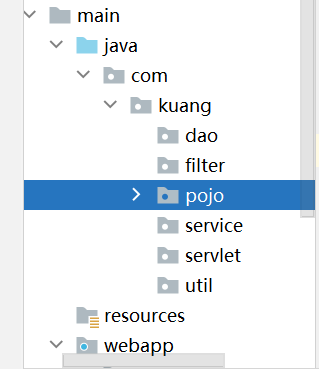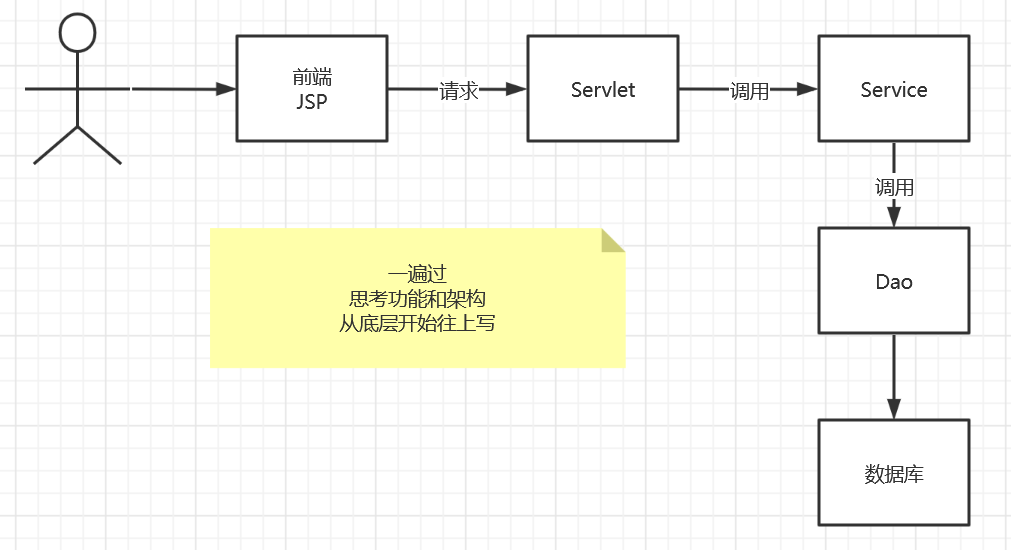JavaWeb实现smbms项目核心功能
SMBMS

数据库:

项目如何搭建?
考虑使用不使用Maven?依赖,Jar
1、项目搭建准备工作
-
搭建一个maven web项目
-
配置Tomcat
-
测试项目是否能够跑起来
-
导入项目中会遇到的jar包;
jsp,Servlet,mysql驱动,jstl,standard...
-
创建项目包结构

-
编写实体类;
ORM映射:表-类映射
-
编写基础公共类
-
数据库配置文件
driver=com.mysql.cj.jdbc.Driver url=jdbc:mysql://localhost:3306?useUnicode=true&characterEncoding=UTF-8&useSSL=true&setServiceTime=GMT username=root password=123456 -
编写数据库的公共类
//操作数据库的公共类 public class BaseDao { private static String driver; private static String url; private static String username; private static String password; //静态代码块,类加载的时候就初始化了 static { Properties properties = new Properties(); //通过类加载器读取对应的资源 InputStream is = BaseDao.class.getClassLoader().getResourceAsStream("db.properties"); try { properties.load(is); } catch (IOException e) { e.printStackTrace(); } driver = properties.getProperty("driver"); url = properties.getProperty("url"); username = properties.getProperty("username"); password = properties.getProperty("password"); } //获取数据库的连接 public static Connection getConnection(){ Connection connection = null; try { Class.forName("driver"); connection = DriverManager.getConnection(url, username, password); } catch (Exception e) { e.printStackTrace(); } return connection; } //编写查询公共类 public static ResultSet execute(Connection connection,String sql,Object[] params,ResultSet resultSet,PreparedStatement preparedStatement) throws SQLException { //预编译的sql,在后面直接执行就可以了 preparedStatement = connection.prepareStatement(sql); for (int i = 0; i < params.length; i++) { //setObject,占位符从1开始,但是我们的数组是从0开始! preparedStatement.setObject(i+1,params[i]); } resultSet = preparedStatement.executeQuery(); return resultSet; } //编写增删改公共方法 public static int execute(Connection connection, String sql, Object[] params, PreparedStatement preparedStatement) throws SQLException { preparedStatement = connection.prepareStatement(sql); for (int i = 0; i < params.length; i++) { //setObject,占位符从1开始,但是我们的数组是从0开始! preparedStatement.setObject(i+1,params[i]); } int updateRows = preparedStatement.executeUpdate(); return updateRows; } //释放资源 public static boolean closeResource(Connection connection,PreparedStatement preparedStatement,ResultSet resultSet){ boolean flag = true; if (resultSet!=null){ try { resultSet.close(); //GC回收 resultSet = null; } catch (SQLException e) { e.printStackTrace(); flag = false; } } if (preparedStatement!=null){ try { preparedStatement.close(); //GC回收 preparedStatement = null; } catch (SQLException e) { e.printStackTrace(); flag = false; } } if (connection!=null){ try { connection.close(); //GC回收 connection = null; } catch (SQLException e) { e.printStackTrace(); flag = false; } } return flag; } } -
编写字符编码过滤器
-
-
导入静态资源
2、登录功能实现

-
编写前端页面
-
设置首页
<!--设置欢迎页面--> <welcome-file-list> <welcome-file>login.jsp</welcome-file> </welcome-file-list> -
编写dao层得到用户登录的接口
DAO:data access object
//得到要登录的用户 public User getLoginUser(Connection connection,String userCode) throws SQLException; -
编写dao接口的实现类
public class UserDaoImpl implements UserDao{ public User getLoginUser(Connection connection, String userCode) throws SQLException { PreparedStatement pstm = null; ResultSet rs = null; User user = null; if (connection!=null){ String sql = "select * from smbms_user where userCode=?"; Object[] params = {userCode}; rs = BaseDao.execute(connection, pstm, rs, sql, params); if (rs.next()){ user = new User(); user.setId(rs.getInt("id")); user.setUserCode(rs.getString("userCode")); user.setUserName(rs.getString("userName")); user.setUserPassword(rs.getString("userPassword")); user.setGender(rs.getInt("gender")); user.setBirthday(rs.getDate("birthday")); user.setPhone(rs.getString("phone")); user.setAddress(rs.getString("address")); user.setUserRole(rs.getInt("userRole")); user.setCreatedBy(rs.getInt("createdBy")); user.setCreationDate(rs.getTimestamp("creationDate")); user.setModifyBy(rs.getInt("modifyBy")); user.setModifyDate(rs.getTimestamp("modifyDate")); } BaseDao.closeResource(null,pstm,rs); } return user; } } -
业务层接口
//用户登录 public User login(String userCode,String password); -
业务层实现类
public class UserServiceImpl implements UserService { //业务层都会调用dao层,所以我们要引入Dao层; private UserDao userDao; public UserServiceImpl() { userDao = new UserDaoImpl(); } public User login(String userCode, String password) { Connection connection = null; User user = null; connection = BaseDao.getConnection(); try { user = userDao.getLoginUser(connection, userCode); } catch (SQLException e) { e.printStackTrace(); } finally { BaseDao.closeResource(connection, null, null); } return user; } } -
编写Servlet
public class LoginServlet extends HttpServlet { //Servlet:控制层,调用业务层代码 @Override protected void doGet(HttpServletRequest req, HttpServletResponse resp) throws ServletException, IOException { System.out.println("LoginServlet--start...."); //获取用户名和密码 String userCode = req.getParameter("userCode"); String userPassword = req.getParameter("userPassword"); //和数据库中的密码进行对比,调用业务层; UserService userService = new UserServiceImpl(); User user = userService.login(userCode, userPassword); //这里已经把登录的人给查出来了 if (user!=null){ //查有此人,可以登录 //将用户的信息放到Session中; req.getSession().setAttribute(Constants.USER_SESSION,user); //跳转到主页 resp.sendRedirect("jsp/frame.jsp"); }else {//查无此人,无法登录 //转发回登录页面,顺带提示它,用户名或者密码错误 req.setAttribute("error","用户名或者密码不正确"); req.getRequestDispatcher("login.jsp").forward(req,resp); } } @Override protected void doPost(HttpServletRequest req, HttpServletResponse resp) throws ServletException, IOException { doGet(req, resp); } } -
注册Servlet
<!--Servlet--> <servlet> <servlet-name>LoginServlet</servlet-name> <servlet-class>com.kuang.servlet.user.LoginServlet</servlet-class> </servlet> <servlet-mapping> <servlet-name>LoginServlet</servlet-name> <url-pattern>/login.do</url-pattern> </servlet-mapping> -
测试访问,确保以上功能成功!
3、登录功能优化
注销功能:
思路:移除Session,返回登录页面
public class LogoutServlet extends HttpServlet {
@Override
protected void doGet(HttpServletRequest req, HttpServletResponse resp) throws ServletException, IOException {
//移除用户的Constants.USER_SESSION
req.getSession().removeAttribute(Constants.USER_SESSION);
resp.sendRedirect(req.getContextPath()+"/login.jsp");//返回登录页面
}
@Override
protected void doPost(HttpServletRequest req, HttpServletResponse resp) throws ServletException, IOException {
doGet(req, resp);
}
}
注册xml
<servlet>
<servlet-name>LogoutServlet</servlet-name>
<servlet-class>com.kuang.servlet.user.LogoutServlet</servlet-class>
</servlet>
<servlet-mapping>
<servlet-name>LogoutServlet</servlet-name>
<url-pattern>/jsp/logout.do</url-pattern>
</servlet-mapping>
登录拦截优化
编写一个过滤器并注册
public class SysFilter implements Filter {
public void init(FilterConfig filterConfig) throws ServletException {
}
public void doFilter(ServletRequest req, ServletResponse resp, FilterChain chain) throws IOException, ServletException {
HttpServletRequest request = (HttpServletRequest) req;
HttpServletResponse response = (HttpServletResponse) resp;
//过滤器,从Session中获取用户,
User user = (User) request.getSession().getAttribute(Constants.USER_SESSION);
if (user==null){ //已经被移除或者注销了,或者未登录
response.sendRedirect("/smbms/error.jsp");
}else {
chain.doFilter(req,resp);
}
}
public void destroy() {
}
}
<!--用户登录过滤器-->
<filter>
<filter-name>SysFilter</filter-name>
<filter-class>com.kuang.filter.SysFilter</filter-class>
</filter>
<filter-mapping>
<filter-name>SysFilter</filter-name>
<url-pattern>/jsp/*</url-pattern>
</filter-mapping>
测试,登录,注销权限,都要保证OK!
4、密码修改
-
导入前端素材
<li><a href="${pageContext.request.contextPath }/jsp/pwdmodify.jsp">密码修改</a></li> -
写项目,建议从底层向上写

-
UserDao接口
//修改当前用户密码 public int updatePwd(Connection connection,int id,int password) throws SQLException; -
UserDao接口实现类
//修改当前用户密码 public int updatePwd(Connection connection, int id, int password) throws SQLException { PreparedStatement pstm = null; int execute = 0; if (connection!=null){ String sql = "update smbms_user set userPassword = ? where id = ?"; Object params[] = {password,id}; execute = BaseDao.execute(connection, pstm, sql, params); BaseDao.closeResource(null,pstm,null); } return execute; } -
UserService层
//根据用户ID修改密码 public boolean updatePwd(int id, int pwd); -
UserService实现类
public boolean updatePwd(int id, int pwd) { Connection connection = null; boolean flag = false; //修改密码 try { connection = BaseDao.getConnection(); if (userDao.updatePwd(connection,id,pwd)>0){ flag = true; } } catch (SQLException e) { e.printStackTrace(); }finally { BaseDao.closeResource(connection,null,null); } return flag; } -
Servlet记得实现复用,需要提取出方法!
@Override protected void doGet(HttpServletRequest req, HttpServletResponse resp) throws ServletException, IOException { String method = req.getParameter("method"); if (method.equals("savepwd")&&method!=null){ this.updatePwd(req, resp); } } public void updatePwd(HttpServletRequest req, HttpServletResponse resp){ //从Session里面拿ID; Object o = req.getSession().getAttribute(Constants.USER_SESSION); String newpassword = req.getParameter("newpassword"); System.out.println("UserServlet"+newpassword); boolean flag = false; //if (o!=null && !StringUtils.isNullOrEmpty(newpassword)){ if (o!=null && newpassword!=null){ UserService userService = new UserServiceImpl(); flag = userService.updatePwd(((User) o).getId(), newpassword); if (flag){ req.setAttribute("message","修改密码成功,请退出,使用新密码登录"); //密码修改成功,移除当前Session req.getSession().removeAttribute(Constants.USER_SESSION); }else { req.setAttribute("message","密码修改失败"); //密码修改成功,移除当前Session } }else { req.setAttribute("message","新密码有问题"); } try { req.getRequestDispatcher("pwdmodify.jsp").forward(req,resp); } catch (ServletException e) { e.printStackTrace(); } catch (IOException e) { e.printStackTrace(); } }<servlet> <servlet-name>UserServlet</servlet-name> <servlet-class>com.kuang.servlet.user.UserServlet</servlet-class> </servlet> <servlet-mapping> <servlet-name>UserServlet</servlet-name> <url-pattern>/jsp/user.do</url-pattern> -
测试
优化密码修改使用Ajax;
-
阿里巴巴的fastjson
<!-- https://mvnrepository.com/artifact/com.alibaba/fastjson --> <dependency> <groupId>com.alibaba</groupId> <artifactId>fastjson</artifactId> <version>1.2.79</version> </dependency> -
后台代码修改
//修改密码 public void updatePwd(HttpServletRequest req, HttpServletResponse resp){ //从Session里面拿ID; Object o = req.getSession().getAttribute(Constants.USER_SESSION); String newpassword = req.getParameter("newpassword"); System.out.println("UserServlet"+newpassword); boolean flag = false; //if (o!=null && !StringUtils.isNullOrEmpty(newpassword)){ if (o!=null && newpassword!=null){ UserService userService = new UserServiceImpl(); flag = userService.updatePwd(((User) o).getId(), newpassword); if (flag){ req.setAttribute("message","修改密码成功,请退出,使用新密码登录"); //密码修改成功,移除当前Session req.getSession().removeAttribute(Constants.USER_SESSION); }else { req.setAttribute("message","密码修改失败"); //密码修改成功,移除当前Session } }else { req.setAttribute("message","新密码有问题"); } try { req.getRequestDispatcher("pwdmodify.jsp").forward(req,resp); } catch (ServletException e) { e.printStackTrace(); } catch (IOException e) { e.printStackTrace(); } } //验证旧密码,session中有用户的密码 public void pwdModify(HttpServletRequest req, HttpServletResponse resp){ //从Session里面拿oldpassword; Object o = req.getSession().getAttribute(Constants.USER_SESSION); String oldpassword = req.getParameter("oldpassword"); //万能的Map : 结果集 HashMap<String, String> resultMap = new HashMap<String,String>(); if (o==null){ //Session失效了,session过期了 resultMap.put("result","sessionerror"); }else if (StringUtils.isNullOrEmpty(oldpassword)){ //输入的密码为空 resultMap.put("result","error"); }else { String userPassword = ((User) o).getUserPassword(); //Session中用户的密码 if (oldpassword.equals(userPassword)){ resultMap.put("result","true"); }else { resultMap.put("result","false"); } } try { resp.setContentType("application/json"); PrintWriter writer = resp.getWriter(); //JSONArray 阿里巴巴的JSON工具类,转换格式 /* resultMap = ["result","sessionerror","result","error"] Json格式 = {key:value} */ writer.write(JSONArray.toJSONString(resultMap)); writer.flush(); writer.close(); } catch (IOException e) { e.printStackTrace(); } } -
测试
5、用户管理实现
思路:

-
导入分页的工具类
-
用户列表页面导入
userlist.jsp
rollpage.jsp
1、获取用户数量
-
UserDao
//根据用户名或者角色查询用户总数 public int getUserCount(Connection connection,String username,int userRole) throws SQLException; -
UserDaoImpl
//根据用户名或者角色查询用户总数【最难理解的SQL】 public int getUserCount(Connection connection, String username, int userRole) throws SQLException { PreparedStatement pstm = null; ResultSet rs = null; int count = 0; if (connection!=null){ StringBuffer sql = new StringBuffer(); sql.append("select count(1) as count from smbms_user u,smbms_role r where u.userRole = r.id"); ArrayList<Object> list = new ArrayList<Object>();//存放我们的参数 if (!StringUtils.isNullOrEmpty(username)){ //拼接sql语句 sql.append(" and u.userName like ?"); list.add("%"+username+"%"); //index:0 } if (userRole>0){ sql.append(" and u.userRole = ?"); list.add(userRole); //index:1 } //怎么把list转换为数组 Object[] params = list.toArray(); System.out.println("UserDaoImpl->getUserCount"+sql.toString()); //输出最后完整的SQL语句 rs = BaseDao.execute(connection, pstm, null, sql.toString(), params); if (rs.next()){ count = rs.getInt("count");//从结果集中获取最终的数量 } BaseDao.closeResource(null,pstm,rs); } return count; } -
UserService
//查询记录数 public int getUserCount(String username, int userRole); -
UserServiceImpl
//查询记录数 public int getUserCount(String username, int userRole) { Connection connection = null; int count = 0; try { connection = BaseDao.getConnection(); count = userDao.getUserCount(connection, username, userRole); } catch (SQLException e) { e.printStackTrace(); } finally { BaseDao.closeResource(connection,null,null); } return count; }
2、获取用户列表
-
userdao
//通过条件查询-userList public List<User> getUserList(Connection connection, String username, int userRole, int currentPageNo, int pageSize) throws Exception; -
userdaoImpl
public List<User> getUserList(Connection connection, String username, int userRole, int currentPageNo, int pageSize) throws Exception { PreparedStatement pstm = null; ResultSet rs = null; List<User> userList = new ArrayList<User>(); if (connection!=null){ StringBuffer sql = new StringBuffer(); sql.append("select u.*,r.roleName as userRoleName from smbms_user u,smbms_role r where u.userRole = r.id"); List<Object> list = new ArrayList<Object>();//存放我们的参数 if (!StringUtils.isNullOrEmpty(username)){ //拼接sql语句 sql.append(" and u.userName like ?"); list.add("%"+username+"%"); //index:0 } if (userRole>0){ sql.append(" and u.userRole = ?"); list.add(userRole); //index:1 } //在数据库中,分页使用 limit startIndex,pageSize; 总数 //当前页 (当前页-1)*页面大小 //0,5 1 0 01234 //5,5 2 5 56789 //10,5 3 10 sql.append(" order by creationDate DESC limit ?,?"); currentPageNo = (currentPageNo-1)*pageSize; list.add(currentPageNo); list.add(pageSize); //怎么把list转换为数组 Object[] params = list.toArray(); System.out.println("sql-->"+sql.toString()); //输出最后完整的SQL语句 rs = BaseDao.execute(connection, pstm, null, sql.toString(), params); while (rs.next()){ User user = new User(); user.setId(rs.getInt("id")); user.setUserCode(rs.getString("userCode")); user.setUserName(rs.getString("userName")); user.setGender(rs.getInt("gender")); user.setBirthday(rs.getDate("birthday")); user.setPhone(rs.getString("phone")); user.setUserRole(rs.getInt("userRole")); user.setUserRoleName(rs.getString("userRoleName")); userList.add(user); } BaseDao.closeResource(null,pstm,rs); } return userList; } -
userService
//通过条件查询-userList public List<User> getUserList(String queryUserName, int queryUserRole, int currentPageNo, int pageSize); -
userServiceImpl
public List<User> getUserList(String queryUserName, int queryUserRole, int currentPageNo, int pageSize) { Connection connection = null; List<User> userList = null; try { connection = BaseDao.getConnection(); userList = userDao.getUserList(connection, queryUserName, queryUserRole,currentPageNo,pageSize); } catch (Exception e) { e.printStackTrace(); } finally { BaseDao.closeResource(connection,null,null); } return userList; }
3、获取角色操作
为了我们职责统一,可以把角色的操作单独放在一个包中,和POJO类对应
RoleDao
public interface RoleDao {
//获取角色列表
public List<Role> getRoleList(Connection connection) throws SQLException;
}
RoleDaoImpl
public List<Role> getRoleList(Connection connection) throws SQLException {
PreparedStatement pstm = null;
ResultSet resultSet = null;
ArrayList<Role> roleList = new ArrayList<Role>();
if (connection!=null){
String sql = "select * from smbms_role";
Object[] params = {};
resultSet = BaseDao.execute(connection, pstm, resultSet, sql, params);
while (resultSet.next()){
Role _role = new Role();
_role.setId(resultSet.getInt("id"));
_role.setRoleCode(resultSet.getString("roleCode"));
_role.setRoleName(resultSet.getString("roleName"));
roleList.add(_role);
}
BaseDao.closeResource(null,pstm,resultSet);
}
return roleList;
}
RoleService
//获取角色列表
public List<Role> getRoleList();
RoleServiceImpl
public class RoleServiceImpl implements RoleService{
//引入Dao
private RoleDao roleDao = null;
public RoleServiceImpl(){
roleDao = new RoleDaoImpl();
}
public List<Role> getRoleList() {
Connection connection = null;
List<Role> roleList = null;
try {
connection = BaseDao.getConnection();
roleList = roleDao.getRoleList(connection);
} catch (SQLException e) {
e.printStackTrace();
} finally {
BaseDao.closeResource(connection,null,null);
}
return roleList;
}
}
4、用户显示的Servlet
- 获取用户前端的数据(查询)
- 判断请求是否需要执行,看参数的值判断
- 为了实现分页,需要计算出当前页面和总页面,页面大小...
- 用户列表展示
- 返回前端
//重点,难点
public void query(HttpServletRequest req, HttpServletResponse resp){
//查询用户列表
//从前端获取数据:
String queryUserName = req.getParameter("queryname");
String temp = req.getParameter("queryUserRole");
String pageIndex = req.getParameter("pageIndex");
int queryUserRole = 0;
//获取用户列表
UserServiceImpl userService = new UserServiceImpl();
List<User> userList = null;
//第一次走这个请求,一定是第一页,页面大小固定的;
int pageSize = 5;//可以把这个写到配置文件中,方便后期修改;
int currentPageNo = 1;
if (queryUserName == null){
queryUserName = ""; //不手动赋值会产生空指针异常
}
if (temp != null && !temp.equals("")){
queryUserRole = Integer.parseInt(temp); //给查询赋值!0,1,2,3
}
if (pageIndex != null){
currentPageNo = Integer.parseInt(pageIndex);
}
//获取用户的总数(分页:上一页,下一页的情况)
int totalCount = userService.getUserCount(queryUserName,queryUserRole);
//总页数支持
PageSupport pageSupport = new PageSupport();
pageSupport.setCurrentPageNo(currentPageNo);
pageSupport.setPageSize(pageSize);
pageSupport.setTotalCount(totalCount);
int totalPageCount = pageSupport.getTotalPageCount(); //总共有几页
//控制首页和尾页
//如果页面要小于1了,就显示第一页的东西
if (totalPageCount<1){
currentPageNo = 1;
}else if (currentPageNo>totalPageCount){ //当前页面大于了最后一项;
currentPageNo = totalPageCount;
}
//获取用户列表展示
userList = userService.getUserList(queryUserName, queryUserRole, currentPageNo, pageSize);
req.setAttribute("userList",userList);
RoleServiceImpl roleService = new RoleServiceImpl();
List<Role> roleList = roleService.getRoleList();
req.setAttribute("roleList",roleList);
req.setAttribute("totalCount",totalCount);
req.setAttribute("currentPageNo",currentPageNo);
req.setAttribute("totalPageCount",totalPageCount);
req.setAttribute("queryUserName",queryUserName);
req.setAttribute("queryUserRole",queryUserRole);
//返回前端
try {
req.getRequestDispatcher("userlist.jsp").forward(req,resp);
} catch (ServletException e) {
e.printStackTrace();
} catch (IOException e) {
e.printStackTrace();
}
}
小黄鸭调试法
6、SMBMS架构分析

作者:wangyudong
本文版权归作者和博客园共有,欢迎转载,但必须给出原文链接,并保留此段声明,否则保留追究法律责任的权利。




【推荐】国内首个AI IDE,深度理解中文开发场景,立即下载体验Trae
【推荐】编程新体验,更懂你的AI,立即体验豆包MarsCode编程助手
【推荐】抖音旗下AI助手豆包,你的智能百科全书,全免费不限次数
【推荐】轻量又高性能的 SSH 工具 IShell:AI 加持,快人一步
· 震惊!C++程序真的从main开始吗?99%的程序员都答错了
· winform 绘制太阳,地球,月球 运作规律
· 【硬核科普】Trae如何「偷看」你的代码?零基础破解AI编程运行原理
· 上周热点回顾(3.3-3.9)
· 超详细:普通电脑也行Windows部署deepseek R1训练数据并当服务器共享给他人